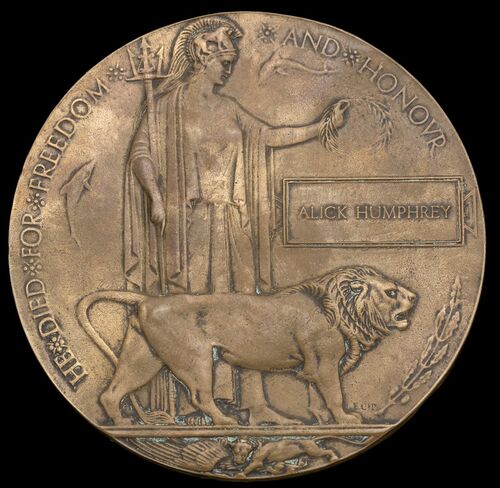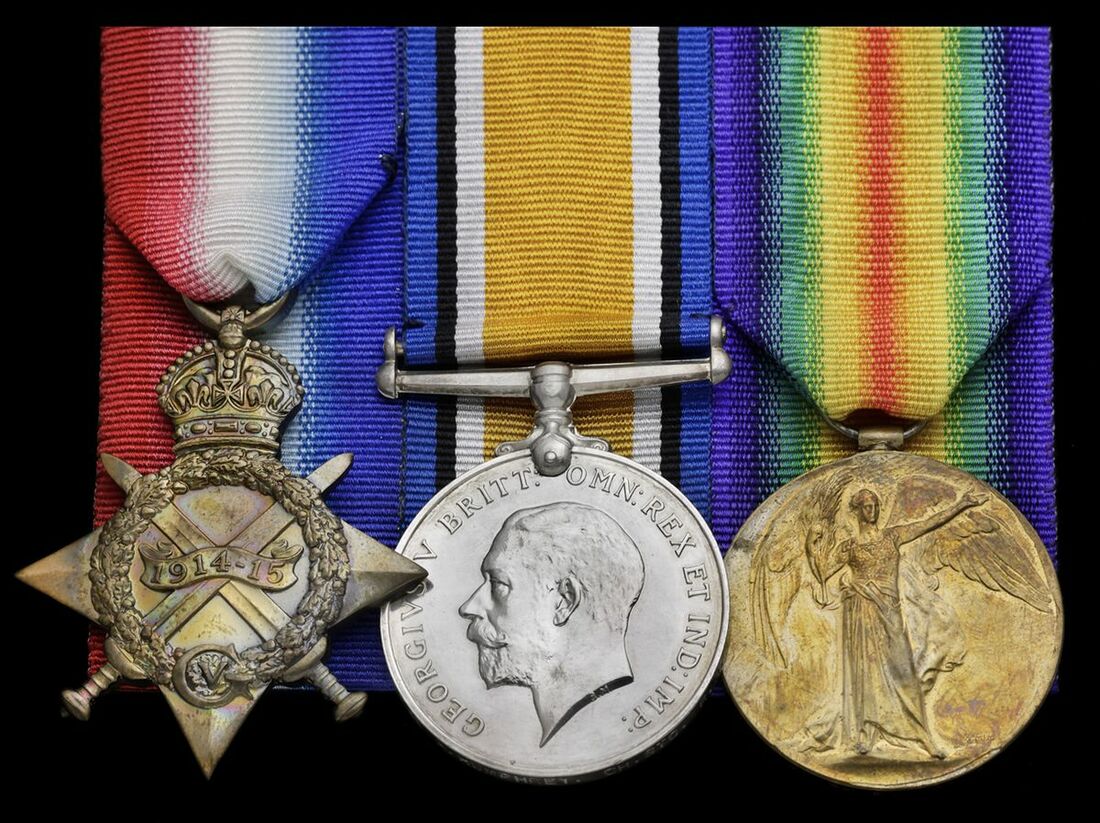Auction: 23001 - Orders, Decorations and Medals
Lot: 122
A remarkable and poignant Great War group of four awarded to Chief Stoker A. Humphrey, killed when the destroyer H.M.S. Hampshire struck a mine off the Orkneys on 5 June 1916 only a week after the involvement in the Battle of Jutland
Amongst those lost that day were Field Marshal Earl Kitchener - the Secretary of State for War - an enormous loss at a time that the nation could hardly afford it
1914-15 Star (283262. A. Humphrey, Ch. Sto., R.N.); British War and Victory Medals (283262 A. Humphrey. Ch. Sto. R.N.); Memorial Plaque (Alick Humphrey) very fine (4)
Alick Humphrey was born at St. Martins, London on 2 July 1872, finding employment as a fireman prior to enlisting in the Navy as a Stoker Class II on 25 August 1896. Promoted Leading Stoker Class II with Caesar on 14 February 1900 and Stoker Petty Officer with the cruiser Psyche. After a turn with H.M.S. Egmont he was posted ashore to Victory I where he was promoted Chief Stoker on 3 March 1909.
Serving mainly ashore for the next five years Humphrey was finally posted to the cruiser Hampshire on 27 January 1914. This vessel was stationed at Wei Hai Wei on the outbreak of the Great War and conducted operations against German territories here. Taking part in the hunt for the commerce raider Emden in 1914 Hampshire was finally posted back to Britain and joined the 7th Cruiser Squadron with the Grand Fleet.
Joining 2nd Cruiser Squadron she was still with this unit which formed part of the cruiser screen for Admiral Jellicoe's battleships. Hampshire took the role of linking ship between the screen and Jellicoe's Flagship Iron Duke. In that role she fired several salvoes at the 2nd Scouting Group but found herself to be out of range. She managed to avoid taking a hit throughout the battle.
With the fighting done the Grand Fleet returned to its station at Scapa Flow and Hampshire was detailed for a special mission. Lord Kitchener himself was travelling to Russia in order to meet with the Government and discuss munition shortages and military strategy. She sailed only to encounter heavy seas, her destroyer escort was lost and she was isolated. Reaching the Marwick Head, about a mile and half off the mainland of Orkney, Hampshire struck a mine laid by U-75. What followed is summarised on the 'Scottish Wreck' website:
'It was around 8.30 p.m. Suddenly the ship was rocked by a loud explosion and almost immediately she was plunged into total darkness as all electrical power failed. Survivors later described the acrid smell of fumes from the exploding mine which permeated the sinking ship as the crew scrambled through the darkness in an attempt to save themselves. The terrifying roar of rushing water could be heard throughout most of the ship. The crew knew instantly that their ship was doomed and that their own chances of survival in the cold, angry seas off Orkney were slim. However, discipline was maintained as the crew rushed to their muster stations and waited the command to abandon ship. Some of the survivors recalled seeing Kitchener on deck before she went down but he and his staff were to perish that night along with the vast majority of the ship's crew of more than six hundred.
The mine had struck on the port side at the forward engine room and had ripped a huge hole in the bottom of the ship. With water quickly filling this huge space the building pressure rapidly smashed the engine room bulkhead and the Hampshire was doomed. The devastation in the engine room itself was appalling with most of the crew in the area killed instantly by the explosion. Elsewhere on the ship the crew flooded the magazine to avoid further explosions while they desperately tried to reach the comparative safety of the deck. However, once on deck the situation was little better. The larger lifeboats could not be launched as they were lowered by electrically powered winches and all power had been lost. A few smaller boats were launched but were immediately smashed against the side of the ship or overturned in the heavy swell throwing their occupants into the boiling sea. The most effective rescue devices were the huge cork Carley floats which were simply hurled into the sea. Many survivors clambered aboard these simple structures. The few seamen who reached the safety of the Carley floats looked back in awe as the huge ship reared her stern high in the air and sank by the bow.
Ashore on Orkney a few islanders actually witnessed the explosion and watched in horror as the huge ship plunged to the seabed. The alarm was raised and a message sent to Stromness. Later, there was considerable controversy over the apparent delays in the rescue efforts. The lifeboat at Stromness was not called out though it must be questionable if it could have reached the area in the dreadful sea conditions that night. In the end it was 9.45 p.m. before the ocean-going tug Flying Kestrel and the trawlers Northward and Renzo put to sea. Over the next few hours many other ships were sent to the scene but it was too late. These ships did not pick up a single survivor.'
In the event only twelve men made it ashore from the 662 crew and passengers aboard. Humphrey was not amongst them. Indeed being a Stoker it is not unreasonable that he was below decks and would have been at the mercy of the sea and the sinking ship. He is commemorated upon the Portsmouth Naval Memorial; sold together with copied research comprising a service record, commonwealth War Graves certificate and extract from the Dictionary of Disasters at Sea During the Age of Steam.
Subject to 20% VAT on Buyer’s Premium. For more information please view Terms and Conditions for Buyers.
Sold for
£420
Starting price
£210







